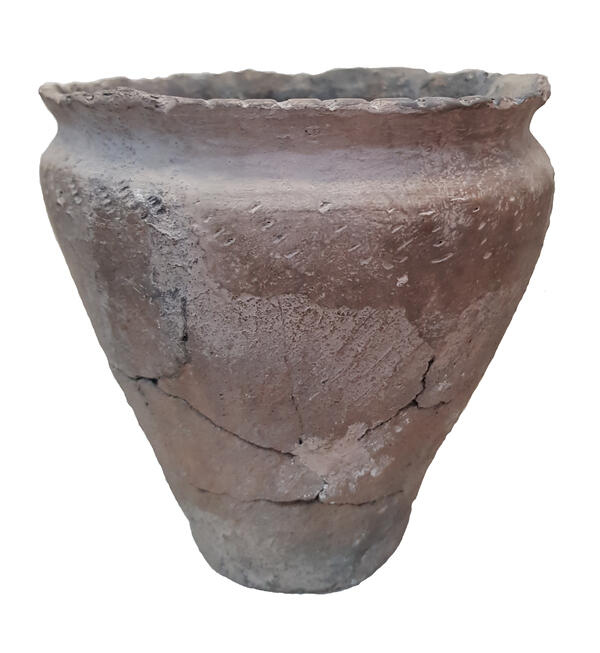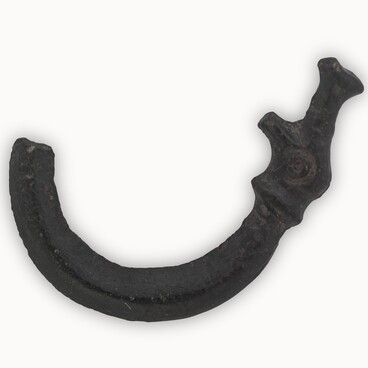The Kursk Regional Museum of Archaeology keeps a hand-molded pot of the 9th — early 11th century. This vessel was found by the archaeologist and specialist in the history of Ancient Rus Vladimir Vasilievich Enukov during the excavations of the Ratsky archaeological complex (Kursk district of the Kursk region) in 1990.
The clay hand-molded pot of gray-brown color was found during the sampling of the first layer of the excavation in the pit № 10. The vessel was broken into fragments, which were reassembled in the course of laboratory work on the material obtained. The height of the pot is 17.5 cm, the diameter of the neck is 16.5 cm. A rope ornament is visible on the shoulder and rim of the throat. The clay dough contains chamotte (refractory clay) and unsorted sand. According on expert analysis, the vessel was not fired in a specialized pottery furnace and the temperature did not exceed 700–800 °C, as indicated by the difference in color on the outside and inside sides of the pot. The outside of the pot is gray-brown, while the inside is dark gray; the clay dough has a black color on the chips and fractures.
The pot was made by the people of the Romensky archaeological culture (early medieval Slavic archaeological culture of the 8th–10th centuries), which more often produced hand-molded dishes than vessels made on the potter’s wheel. Scholars correlate the Romensky culture with the recorded in chronicles Slavic tribes of Severians, who inhabited the territories along such large rivers as the Svapa, Usozha, Seim, Tuskar, Reut, Snova, Psyol, and Sula.
Pottery made of fired clay is the most common find during archaeological excavations. However, the vast majority of pottery is preserved only in fragments. There are many reasons for this: the pot could have been broken before it was discovered, the whole pot could have fragmented into many pieces over hundreds of years or even millennia, and burrowing animals could have dragged the shards into different directions, sometimes a few meters from where they were originally buried. Finding a intact vessel in its original form is always a great stroke of luck for researchers. As a rule, the reconstruction of the original form of ancient pottery is made by gluing together fragments of pottery, which are found in compact clusters in the archeological deposits or during the sampling of artifacts.
The clay hand-molded pot of gray-brown color was found during the sampling of the first layer of the excavation in the pit № 10. The vessel was broken into fragments, which were reassembled in the course of laboratory work on the material obtained. The height of the pot is 17.5 cm, the diameter of the neck is 16.5 cm. A rope ornament is visible on the shoulder and rim of the throat. The clay dough contains chamotte (refractory clay) and unsorted sand. According on expert analysis, the vessel was not fired in a specialized pottery furnace and the temperature did not exceed 700–800 °C, as indicated by the difference in color on the outside and inside sides of the pot. The outside of the pot is gray-brown, while the inside is dark gray; the clay dough has a black color on the chips and fractures.
The pot was made by the people of the Romensky archaeological culture (early medieval Slavic archaeological culture of the 8th–10th centuries), which more often produced hand-molded dishes than vessels made on the potter’s wheel. Scholars correlate the Romensky culture with the recorded in chronicles Slavic tribes of Severians, who inhabited the territories along such large rivers as the Svapa, Usozha, Seim, Tuskar, Reut, Snova, Psyol, and Sula.
Pottery made of fired clay is the most common find during archaeological excavations. However, the vast majority of pottery is preserved only in fragments. There are many reasons for this: the pot could have been broken before it was discovered, the whole pot could have fragmented into many pieces over hundreds of years or even millennia, and burrowing animals could have dragged the shards into different directions, sometimes a few meters from where they were originally buried. Finding a intact vessel in its original form is always a great stroke of luck for researchers. As a rule, the reconstruction of the original form of ancient pottery is made by gluing together fragments of pottery, which are found in compact clusters in the archeological deposits or during the sampling of artifacts.



